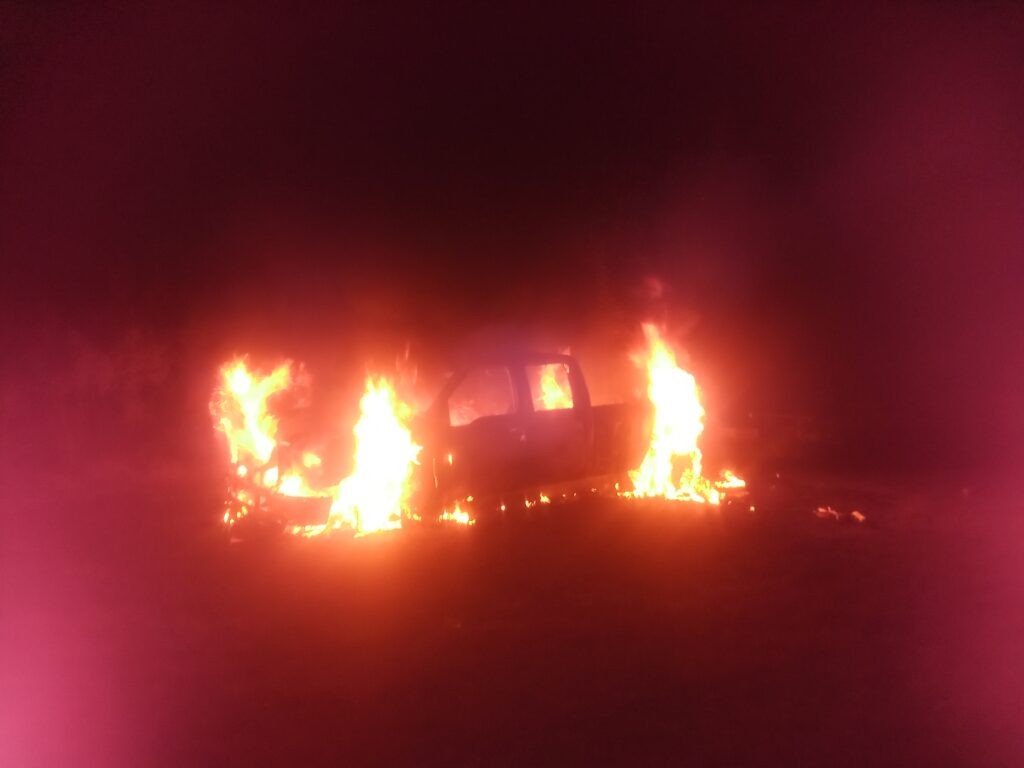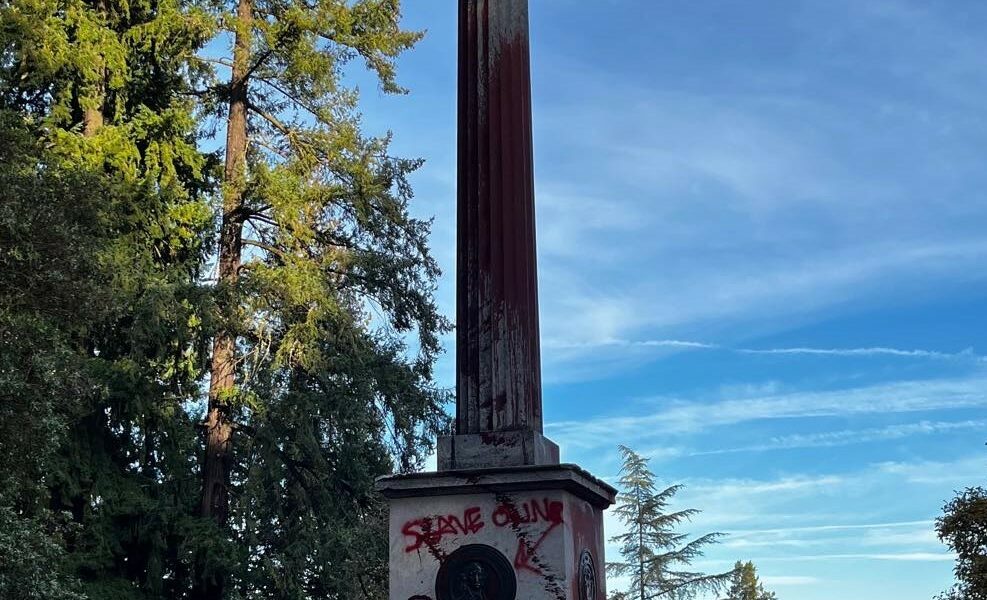 Download pamphlet: Print – Tabloid [For a Risograph]
Download pamphlet: Print – Tabloid [For a Risograph]
Download action posters: Print – Tabloid
Diversity of tactics is a concept that has been used to break the hegemony of non-violence in social movements. The term can be understood as a shared principle that advocates respect and solidarity across different approaches with the aim of breaking down moralistic and ideological divisions. Tactics, however, are often confused with methods, leading to a dangerous misuse of the idea of diversity of tactics to advocate for tolerance of or collaboration with authoritarian, populist, or democratic initiatives.
Since Night Owls focuses on sabotage, which is a tactic, and direct action, which is a method, we want to dive into these ideas and how they might relate to anarchist struggle more broadly. Tactics can be understood as what you do and methods as how you do it. Tactics change according to the moment and the needs of the struggle, whereas methods are stable and well-defined, remaining consistent across contexts, though how methods are understood and developed will vary.
Smashing something or lighting something on fire does not necessarily contribute to the struggle against domination if it is carried out using authoritarian or reformist methods. Pushing forward confrontational tactics while failing to be critical of the methods employed can lead anarchists to enact a sort of “leftism with teeth:” when conflictual efforts are subsumed by dominant political forces and used to grease the wheels of the democratic process. Among other reasons, many anarchists focus on developing autonomous methods of struggle to avoid becoming foot soldiers of the left—diverting a liberatory project into voting with bricks.
On the other hand, reducing the anarchist project to militant tactics can create hierarchies where some tactics are valued above others, instead of understanding how different tactics work together in an ecosystem of actions and ideas. This can lead to the uncritical valorization of militancy for militancy’s sake, fertile ground for the creep of militarism into radical struggles, risking the transformation of a dynamic social conflict into a conflict between isolated militant actors and the state.
Central to anarchism is the method of direct action, which is self-organized by definition. Direct action and sabotage are often used interchangeably, but this is a mistake—many tactics, including sabotage but also those considered “peaceful” such as wheatpasting posters around your neighborhood, can be approached through the method of direct action. The word ‘direct’ here means without mediation; without any intermediary, representative, central committee, union, or other leaders—formal or informal—between you and action. It is a refusal of the logic of democracy; of engaging in dialogue with power, of waiting, of compromise. Tactics such as collaborating with political parties or mass media are incompatible with an anarchist understanding of diversity of tactics: they violate the principle of self-organization, instead reproducing alienation and centralization. By using reformist methods, these tactics foment divisions between actors and spectators, representatives and represented, snuffing out self-organization and the potential for social contagion. Reformist mentalities can often even find their way into action claims, as Let’s Talk About Attack aptly proposes to do away with:
It’s not about bringing a mean company to better intentions, of forcing it to change its bad habits via punitive measures, nor of pressuring an institution to change its mind. […] when we’re talking about, for example, companies that build prisons, high speed train lines, airports, let’s refuse all forms of communication (even the radical ones) with the enemy; let’s refuse all forms of reformism. Better still: we don’t want to spread the logic of reformism, we want to destroy it. The goal is, then, not to convince (by way of damage, material or monetary); the goal is to sabotage and attack the entirety of the project on all terrains. Attack – not to convince, but because we are convinced we don’t want this project. Attacking, not to punish, but to make life harder for the enemy. From the construction companies to the security coordinators and engineers; from the civilian participants to the banks who finance the project.
This column is especially interested in actions that inspire new conceptions of anarchists’ role and potential impact, in which tactics are innovated through creativity and experimentation. In a recent action against a police shooting range in Atlanta’s Weelaunee forest, some “chainsaw-wielding militants’” knocked out the power line feeding the range before going on to destroy the cameras. This action showed creativity both in its choice of target and the tactics used, in an intelligent and effective blow to the facility’s ability to operate. It demonstrates a shift in focus from the mere symbolic facades of power and reminds us that we are not just against Cop City, but the entire institution of policing.

Privileging tactical preferences over shared ethics, goals, and methods can be flimsy ground for collaboration. For example, people who use high-risk tactics but are motivated by a desire to impact public opinion can make unreliable and even dangerous co-conspirators. Many of those who snitched in the Green Scare “revered public opinion about an environmental movement rather than aiming to destroy anti-environmental forces.” More recently, two individuals confessed to having attacked pipelines in a statement to the media, demonstrating a similar desire to impact public opinion—one later became a cooperating witness, while the other, who stayed solid, regretted publishing her identity. People driven by such motivations are liable to change their minds as the tides of “public opinion” inevitably change. Understanding one’s goals and motivations for acting is indispensable, not only for deciding who to take risks with, but also for deciding what to target and how.
This does not mean that you have to be an anarchist to use direct action or to be trustworthy. We are less invested in more people calling themselves anarchists than in the spreading of practices of self-organization and conflict with authority, which were around long before anarchism was named. Our understanding of anarchist methods can grow and deepen by learning from other self-organized struggles and individuals who sabotage domination.
In compiling this column’s list of actions across the so-called United States, we include actions that were claimed with a communique as well as those that were not, with the assumption that there are lessons to be learned from both. The advantages and disadvantages of writing communiques have often been the subject of heated debate among anarchists. Many actions speak for themselves and do not have to be claimed to be understood or to significantly disrupt systems of domination. On the other hand, actions that are not claimed may be harder to find on the internet and so feature less prominently in counter-information projects (including this one), though such websites are rarely engaged with by anyone who’s not themselves an anarchist. In putting together this column, we try to consider the challenge of communicating outside of the anarchist space—which depends on our newspapers, posters, zines, social centers, and physical places of encounter within the struggle.
The torching of three police cars in Pittsburgh this fall was not accompanied by a communique, but the burnt-out shells of the cruisers spoke for themselves and the message could not have been clearer: Fuck the police. We feel it’s important not to speculate about whether this or other actions were carried out by anarchists or not, since that has the potential to aid the police in their investigations. Whatever the motivations of the anonymous one(s) who burned the cars, this action can resonate with anyone who has their own reason to hate and take action against the police.
On the other hand, communiques can also have their own very important place, and all the better when that place is not just the Internet! Although we chose this medium for our column in the interest of reaching a wider audience, we also include a zine version and posters so as to take these ideas and actions off the screen, with its inherent alienation, and spread them through our real world encounters.
This season’s posters feature a communique from occupied Anishinabewaki and Odawa territory (northern Michigan) which claims the arson of heavy machinery at an Enbridge facility. The fight against pipelines and the extractive economy is not restricted to occupations against their construction and is not defeated after they go into the ground. The communique reminds us that the extractive economy, along with the devastation it causes, is all around us, and that it’s possible to fight back.

Earth- and animal-liberation focused struggles continued to take major risks to defend land and life over the course of the fall season. Decentralized supporters of the Defend the Atlanta Forest campaign carried out at least ten known direct actions altogether against Cop City, all of them daring and impressive. Meanwhile, we saw a return of Animal Liberation Front fur farm raids, which according to reports released 15,800 mink in total, destroyed vehicles and machinery at one farm, and ultimately forced the closure of Lion Farms, the largest mink exploiter in the U.S. and the target of one of the actions.
As the recent commentary “On Mink Liberation” notes, “Whilst [mink liberation actions] behave like any other animal liberation action—freeing animals from their place of abuse—they are understood easier as a sabotage action.” It’s heartwarming enough to see these individual lives freed from captivity and given a second chance, yet these actors also took care to aim at the mechanisms of the fur industry itself—an industry that’s entirely intertwined with and made possible by the domination of this territory by capitalism and colonization. The most recent mink raid’s communique makes this connection as well, ending: “free all prisoners and give the land back.”
Our last column centered on the significance of our settler colonial context, not only for forest defense and other ecological struggles, but also with regard to how we position ourselves in relation to land, life, and collective survival—with the ultimate objective of destroying the settler colony and returning its territory to the continent’s original inhabitants. This autumn saw a heartening expansion of anti-colonial solidarity actions, from Washington and Oregon to Michigan and Philadelphia. Some of these actions happened in response to solidarity calls, one took place on the colonial holiday Columbus Day, one on Thanksgiving, and another responded in part to the brutal consequences of climate collapse in the Global South. In discussing the need to take apart elements of colonial industry and infrastructure, the communiques attest to the ways in which destructive acts, when paired with anti-colonial methods, can help empower people to move towards self-organization and action, nurture non-hierarchical relationships, and cultivate “communities of collective resistance and joyful militancy.”
Distribution of Night Owls is decentralized—don’t forget to print the column, bring it to infoshops, drop it in newspaper boxes, or just pass it to your friends.
Action Briefs
9/25: Mountain Brook, Alabama
The chairman and CEO of Brasfield & Gorrie, the general contractor behind Atlanta’s Cop City, was visited at night by “fey (un)painter’s union.” The cars in his driveway were splashed with lacquer thinner, their windows etched, and the house was redecorated with pink paint.
9/28: Pittsburgh, Pennsylvania
Three police cruisers were burned outside of a police training facility.
10/05: Northern Michigan (occupied Anishinabewaki and Odawa territory)
Machinery is torched inside of an Enbridge facility, signed by “the first of many.” “i write this while the black snakes beneath my feet prepare once again to go under the mackinac straits, a sacred place where all of the great lakes converge. the great lakes which make of nearly 20% of the world’s fresh water. we must not let this happen.”
10/6: Atlanta, Georgia
Stake Center and City of Atlanta workers are ambushed while doing survey work near the Atlanta forest, leaving behind broken windows and slashed tires. “If you come to the woods to do something other than defend the forest, expect to have car problems.”
10/10: Atlanta, Georgia
Georgia power work trucks and boom cranes “were descended upon with rocks & fire at the very edge of forest otherwise known as the old prison farm.[…] May the Pines & other oaks & fruit trees you fell one day fall on & destroy your personal homes & vehicles!”
10/12: Philadelphia, Pennsylvania
A colonizer statue was vandalized on Columbus day. “Fighting colonization is a way to nurture a less hierarchical relation with the land and those that live on it.”
10/12: Longmeadow, Massachusetts
An individual unleashed a hive full of bees on sheriff’s deputies, some of them allergic to bee stings, as they tried to serve an eviction notice.
10/18: Atlanta, Georgia
Unknown assailants broke into the massive Shadowbox Studios movie complex, involved in the destruction of the Atlanta forest, and managed to partially burn down a structure used as a dressing room. “We don’t like movies. We don’t like screens. We are in the real world: Unseen to the Hypno-Dystopic Civilization around us, Somewhere among shadow and tree.”
10/18: Michigan
“Stop Camp Grayling” and “Stop All Cop Cities” are graffitied onto three police cars somewhere in Michigan.
11/5: Atlanta, Georgia
A surveillance camera at the old prison farm is cut down.
11/5: Thurston County, Washington
Many trees are spiked in solidarity with the Wet’suwet’en on a day of action, to discourage logging. “All of these industries are on the side of Coastal Gas Link and they are all our enemies. We feel the rage, creativity, and determination of the people of Wet’suwet’en and Wedzin Kwa, and must all act against every aspect of colonial industry which threatens the sovereignty and lifeblood of lands and waters. We hope this message serves as a warning to deter all upcoming timber sales in the Capitol Forest. If the trees are cut, we hope for maximum damage to the chainsaws and mills.”
11/5: Philadelphia, Pennsylvania (Lenapehoking)
On the Wet’suwet’en day of action, “a small group of Anti-colonial Anarchist settlers in Lenapehoking blockaded a chokepoint of a high frequency railway.”

Source: Scenes from the Atlanta Forest
11/8: Massillon, Ohio
The ALF liberates 1,000 mink in memory of Barry Horne. “Check out finalnail.wordpress.com to find a list of animal torture and murder facilities.”
11/8: Atlanta, Georgia
Another tow truck is burned near the Atlanta forest, as it tries to clear the charred remains of a tow truck burned back in July. “Meanwhile, those Americans that still believe in the ritual of voting were casting their ballots for the maintenance of one or the other version of the status quo. They think of this as freedom, as though the choice between 100 brands of cereal were the same as choosing how to live. We chose another route. We chose to defend a territory that has been claimed by the people, for the people–where the police do not dare to go because they have seen what happens to enemy vehicles. We elected a raging fire beneath a full moon!”
11/9: Michigan
The ALF liberate 800 more mink from Pipkorn Farm.
11/11: Atlanta, Georgia
An excavator belonging to Norfolk Southern adjacent to the Weelaunee forest is “decommissioned by fire.” Norfolk Southern is a supporter of the Cop City project.
11/15: Hoaglin Township, Ohio
10,000 mink are released from Lion Farms; graffiti is left at the scene reading “(A)LF” and “We’ll be back.”
11/19: Atlanta, Georgia
The Atlanta Police Department’s shooting range inside the Weelaunee forest is attacked on several fronts. Trees are felled with a chainsaw to block access to the road, and one tree destroys the power line providing electricity to the range. The cameras are then destroyed with fire and hammers. “We took this action for the dead – for Rayshard Brooks and every person killed by the Atlanta Police, for every murdered revolutionary, for the Muskogee who were forced from this land, for every enslaved person who lived and died on the plantation here, for every prisoner killed by guards at the old prison farm and buried in unmarked graves in the forest. This forest is theirs and we will not allow the police to desecrate it with their presence.”
11/20: Portland, Oregon
Most buildings at the Adidas North American headquarters were smashed up several hours before the opening of the 2022 World Cup. “We shattered windows, broke doors and covered walls with paint across the corporate campus, including office buildings, the gym and cafe. Adidas is one of FIFA’s primary long-term partners, and a main sponsor of the World Cup in Qatar this year. The history of the World Cup is one of death and displacement.”
11/21: Milwaukee, Oregon
A KONE service truck was set ablaze in solidarity with Alfredo Cospito, an anarchist prisoner in Italy on indefinite hunger strike against his transfer to the 41 Bis regime. “The multinational corporation KONE[,] a manufacturer of elevators, escalators, and door systems[,] has contracts with prisons and military facilities worldwide, including the Aviano NATO Air Base in Northeastern Italy, through their subsidiary KONE SPA.”
11/22: Asheboro, North Carolina
A Confederate monument outside of the Randolph County courthouse was vandalized with “derogatory words about the United States.”

Source: Rose City Counter-Info
11/24: Portland, Oregon
In the early morning hours of “Thanksgiving,” some anarchists vandalized a colonial statue. Chunks were broken off, it was doused in red paint, and the plaque was ripped off and dumped in the river. It was redocorated with “Land Back” and other slogans.
11/27: Plainwell, Michigan
Vandals cause over $75,000 in damage to Michigan Gold Course. The club’s head said “you’re better off putting out of a ditch on the side of the road than you are being able to putt on our greens right now”.
11/30: Atlanta, Georgia
A surveillance camera is destroyed by “some forest creatures” near the Welaunee forest in solidarity with opposing the expansion of Camp Grayling, a National Guard training facility. Flock Security cameras is an investor in both Camp Grayling and the Cop City project.
12/11: Wayland, Michigan
4,000 mink are liberated from Scholten Farms using four ramps built with the farm’s materials. The mink-killing machine, pvc water pipes, and all ten vehicles on the property were sabotaged using bleach, water, and sand in their gas tanks and oil reservoirs.
12/13: New York, New York
A massive fire broke out at an NYPD evidence warehouse in Brooklyn, likely destroying mountains of criminal evidence—including DNA records—stretching back decades.
12/13: Atlanta, Georgia
A noise demo was held at DeKalb County Jail in solidarity with five people arrested on the same day during a raid of the Atlanta forest. “Fifteen minutes in, one rowdy prisoner was spotted lighting a fire outside their cell window, which appeared to have been smashed out for the occasion. Peering through binoculars, one noise-maker noticed an arm waving a sheet out of a third story window that also was smashed”
12/16: San Francisco, California
Five windows and an ATM were smashed at a Wells Fargo in retribution for the arrest of five Atlanta forest defenders on “domestic terrorism” charges. “Mitch Graul, a Lead Business Execution Consultant at Wells Fargo, sits on the Board of Trustees of the Atlanta Police Foundation. […] The bones in the land demand a reckoning. Anyone who supports Cop City is a target everywhere. Solidarity means attack!”
12/16: Oakland, California
The offices of CEL, owned by Atlas Technical Consultants and involved in the Cop City project in Atlanta, had their windows broken and locks glued “as part of a battle over whats left of the living world. […] To those on our side of the barricade: beware of the politicians in our midst, not just those concerned with electoral victory but also those who want to use you as pawns in THEIR revolution. Understand your values and why you choose to take action. Political strategy is not a substitute for genuine connection to yourself, each other, and whats left of the living world. Against the pig world and its dead future of machines, surveillance and alienation! Against politics! In solidarity with all those arrested! For all the forests and our friends! Long live anarchy!”
12/17: Novi, Michigan
An Atlas office loses its windows in solidarity with forest defenders in Atlanta, and paint is poured at the doorstep.
12/18: Crawford County, Michigan
More than 100 trees are spiked around the proposed Camp Grayling expansion area.
12/21: Manhattan, New York
The apartment building of a vice president of AtlaVista, a part of Atlas Technical Consultants, is redecorated in solidarity with the six arrested Weelaunee forest defenders. “We reject this world order of prisons and pigs and dead forests, we reject their false peace, we reject the state in its entirety!”
photo: Jo-Anne McArthur via Unsplash

